2007 Hyundai H-1 (Grand Starex) brakes
[x] Cancel search: brakesPage 76 of 284

2
INSTRUMENTS AND CONTROLS
9
B260G01A-AAT
Low Oil Pressure Warning Light CAUTION:
If the oil pressure warning light stays on while the engine is running, seri-ous engine damage may result. The oil pressure warning light comes on whenever there is insufficient oilpressure. In normal operation, it should come on when the ignition switch is turned on, then go outwhen the engine is started. If the oil pressure warning light stays on while the engine is running, there may bea serious malfunction. If this happens, stop the car as soon as it is safe to do so, turn off theengine and check the oil level. If the oil level is low, fill the engine oil to the proper level and start the engineagain. If the light stays on with the engine running, turn the engine off immediately. In any instance wherethe oil light stays on when the en- gine is running, the engine should be checked by an authorizedHyundai dealer before the car is driven again.
!
!
B260H03A-AAT Parking Brake/Low Brake Fluid Level Warning Light If the parking brake is not applied, the warning light should come on when theignition switch is turned to "ON" or "START", then go out when the engine starts. If the light comes on at anyother time, you should slow the vehicle and bring it to a complete stop in a safe location off the roadway.The brake warning light indicates that the brake fluid level in the brake mas- ter cylinder is low and hydraulic brakefluid conforming to DOT 3 or DOT 4 specifications should be added. After adding fluid, if no other trouble is found,the car should be immediately and carefully driven to a Hyundai dealer for inspection. If further trouble is experi-enced, the vehicle should not be driven at all but taken to a dealer by a professional towing service or someother safe method.
WARNING:
If you suspect brake trouble, have your brakes checked by a Hyundaidealer as soon as possible. Driving your car with a problem in either the brake electrical system or brake hy-draulic system is dangerous, and could result in a serious injury or death. Warning Light Operation The parking brake/brake fluid level warning light should come on when the parking brake is applied and the igni- tion switch is turned to "ON" or"START". After the engine is started, the light should go out when the park- ing brake is released.
Page 92 of 284
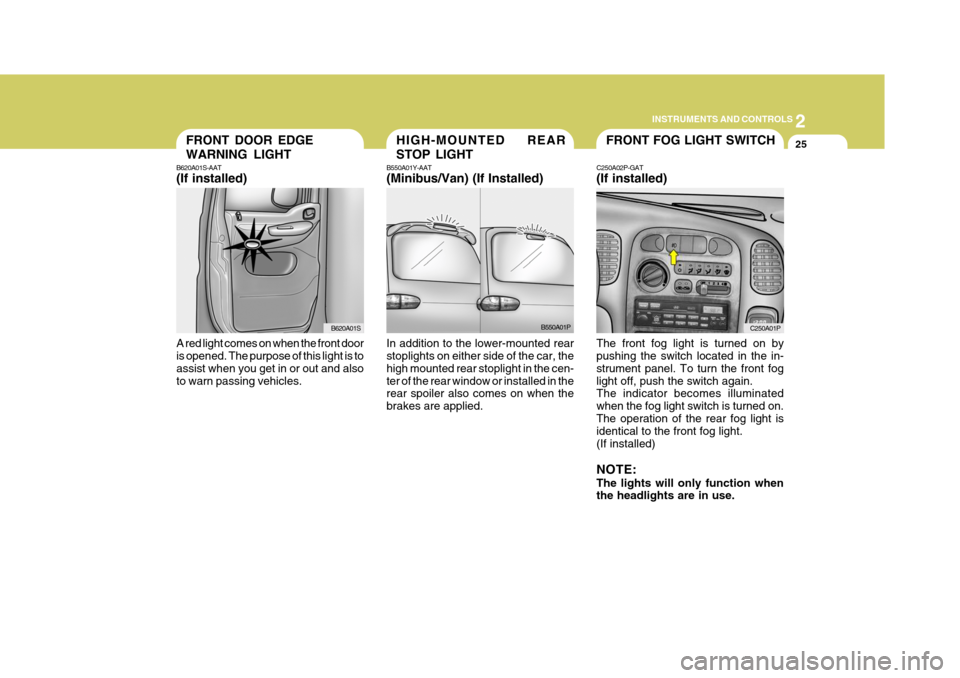
2
INSTRUMENTS AND CONTROLS
25FRONT FOG LIGHT SWITCH
C250A02P-GAT (If installed) The front fog light is turned on by pushing the switch located in the in- strument panel. To turn the front foglight off, push the switch again. The indicator becomes illuminated when the fog light switch is turned on.The operation of the rear fog light is identical to the front fog light. (If installed) NOTE: The lights will only function when the headlights are in use. C250A01PFRONT DOOR EDGE WARNING LIGHT
B620A01S-AAT (If installed) A red light comes on when the front door is opened. The purpose of this light is to assist when you get in or out and alsoto warn passing vehicles. B620A01SHIGH-MOUNTED REAR STOP LIGHT
B550A01Y-AAT (Minibus/Van) (If Installed) In addition to the lower-mounted rear stoplights on either side of the car, the high mounted rear stoplight in the cen-ter of the rear window or installed in the rear spoiler also comes on when the brakes are applied. B550A01P
Page 151 of 284

3
STARTING AND OPERATING
9
C070E03A-GAT RECOMMENDED SHIFT POINTS The shift points as shown above are recommended for optimum fuel economy and performance.
Shift
from-to 1-2 2-3 3-44-5 Recommended
20 km/h (15 mph)40 km/h (25 mph) 55 km/h (35 mph) 75 km/h (45 mph)
NOTE:
o To shift into reverse, rest the le- ver in neutral for at least 3 sec- onds after your car is completelystopped. Then move the lever into the reverse position.
o During cold weather, shifting may be difficult until the transmis-sion lubricant has warmed up. This is normal and not harmful tothe transmission.
o If you've come to a complete stop
and it's hard to shift into 1st or"R", put the shift lever in "N" position and let up on the clutch. Press the clutch pedal back down,and then shift into 1st or "R" gear position.
o Do not use the shift lever as a handrest during driving, as thiscan result in premature wear of the transmission shift forks. CAUTION:
When downshifting from fifth gearto fourth gear, caution should be taken not to inadvertently press the gear lever sideways in such a man-ner that second gear is engaged. Such a drastic downshift may cause the engine speed to increase to thepoint that the tachometer will enter the red-zone. Such over-revving of the engine may possibly cause en-gine damage.
!
D050B01P-GAT Using the Clutch The clutch should be pressed all the way to the floor before shifting, then released slowly. Do not rest your footon the clutch pedal while driving. This can cause unnecessary wear. Do not partially engage the clutch tohold the vehicle on an incline. This causes unnecessary wear. Use the parking brake to hold thevehicle on an incline. Do not operate the clutch pedal rapidly and repeat- edly. C070D02O-AAT Good Driving Practices
o Never take the vehicle out of gear
and coast down a hill. This is ex- tremely hazardous. Always leavethe vehicle in gear.
o Don't "ride" the brakes. This can
cause them to overheat and mal-function. Instead, when you are driv- ing down a long hill, slow down and shift to a lower gear. When you dothis, engine braking will help slow the car.
Page 155 of 284

3
STARTING AND OPERATING
13
If you need to accelerate rapidly, press the accelerator pedal all the way to thefloor. The transmission will automati- cally shift to a lower gear, depending on the speed. NOTE: Turn the overdrive switch on for good fuel economy and smooth driving. If engine braking is neededin the "D" range or if repeated up- shifting and downshifting between the 3rd and 4th gear is needed whenclimbing a gentle slope, it is recom- mended that the overdrive switch be turned off. Turn the overdriveswitch back on immediately after- ward.
CAUTION:
o Shift into "R", "D" and "P" only when the vehicle has completelystopped.
o Do not accelerate the engine in
the reverse or any of the forwardpositions with the brakes applied.
o Always apply the footbrake when
shifting from "P" or "N" to "R","D", "2" or "L" position.
o Do not use the "P" position in
place of the parking brake. Al-ways set the parking brake, shift the transmission into "P" and turn off the ignition when you leave the vehicle, even momen-tarily. Never leave the vehicle unat- tended while the engine is run-ning.
o Check the automatic transmis-
sion fluid level regularly, and addfluid as necessary. See the maintenance schedule for the proper fluid recommen-dation.
! D080A01P-GAT OVERDRIVE SWITCH (If installed) When the overdrive switch is turned on, the transmission will automatically upshift to the second, third and over- drive gears. When the overdrive switchis turned off, the transmission will not upshift to the overdrive gear at all. For normal driving, the selector levershould be left in the "D" position and the overdrive switch turned on. To move the selector lever, the push but-ton on the selector lever handle may have to be depressed first.D080A01P
Page 157 of 284
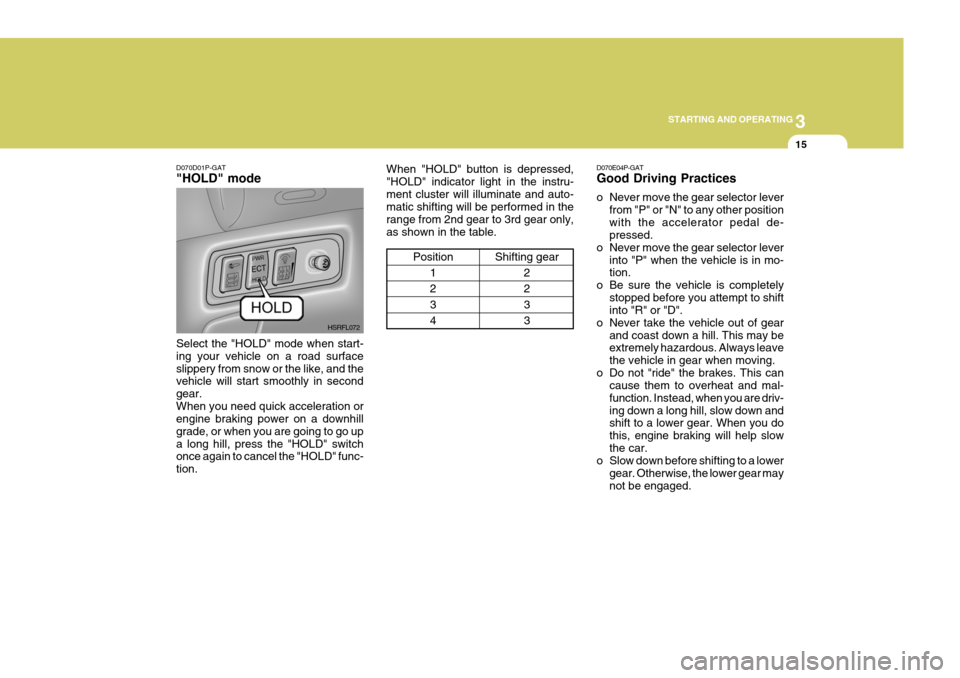
3
STARTING AND OPERATING
15
D070E04P-GAT Good Driving Practices
o Never move the gear selector lever
from "P" or "N" to any other position with the accelerator pedal de- pressed.
o Never move the gear selector lever into "P" when the vehicle is in mo-tion.
o Be sure the vehicle is completely stopped before you attempt to shiftinto "R" or "D".
o Never take the vehicle out of gear and coast down a hill. This may beextremely hazardous. Always leave the vehicle in gear when moving.
o Do not "ride" the brakes. This can cause them to overheat and mal-function. Instead, when you are driv-ing down a long hill, slow down and shift to a lower gear. When you do this, engine braking will help slowthe car.
o Slow down before shifting to a lower
gear. Otherwise, the lower gear maynot be engaged.
D070D01P-GAT "HOLD" mode Select the "HOLD" mode when start- ing your vehicle on a road surfaceslippery from snow or the like, and the vehicle will start smoothly in second gear.When you need quick acceleration or engine braking power on a downhill grade, or when you are going to go upa long hill, press the "HOLD" switch once again to cancel the "HOLD" func- tion.
When "HOLD" button is depressed,"HOLD" indicator light in the instru-ment cluster will illuminate and auto- matic shifting will be performed in the range from 2nd gear to 3rd gear only,as shown in the table.
Position1 2 34
Shifting gear 2 2 33
HSRFL072
Page 163 of 284
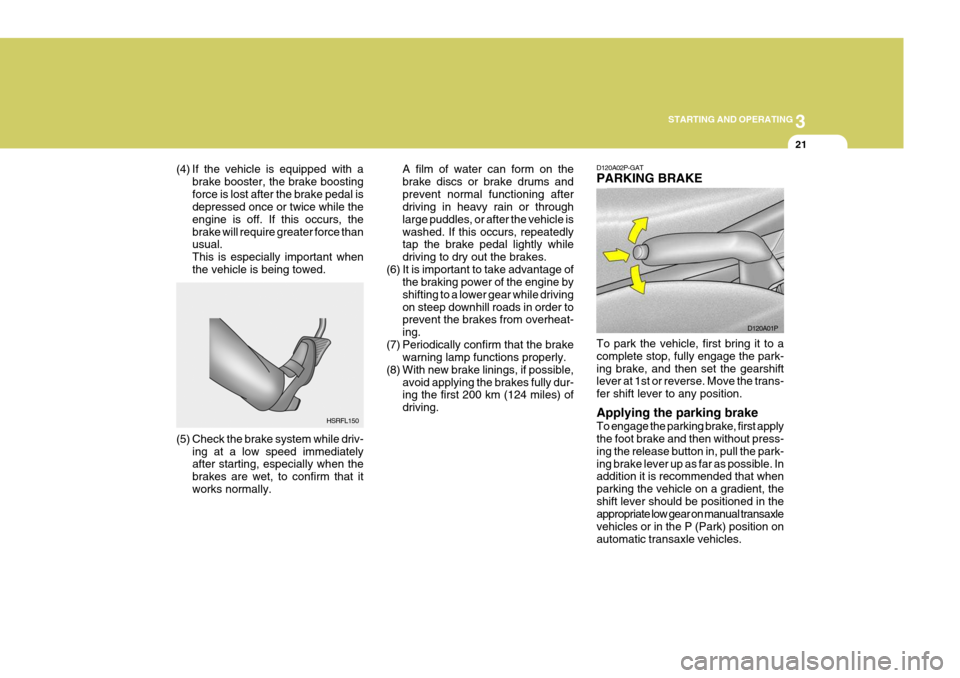
3
STARTING AND OPERATING
21
(4) If the vehicle is equipped with a
brake booster, the brake boosting force is lost after the brake pedal is depressed once or twice while the engine is off. If this occurs, thebrake will require greater force than usual. This is especially important whenthe vehicle is being towed. A film of water can form on thebrake discs or brake drums andprevent normal functioning after driving in heavy rain or through large puddles, or after the vehicle iswashed. If this occurs, repeatedly tap the brake pedal lightly while driving to dry out the brakes.
(6) It is important to take advantage of the braking power of the engine byshifting to a lower gear while drivingon steep downhill roads in order to prevent the brakes from overheat- ing.
(7) Periodically confirm that the brake warning lamp functions properly.
(8) With new brake linings, if possible, avoid applying the brakes fully dur- ing the first 200 km (124 miles) of driving.
HSRFL150
(5) Check the brake system while driv- ing at a low speed immediately after starting, especially when the brakes are wet, to confirm that itworks normally. D120A02P-GAT PARKING BRAKE To park the vehicle, first bring it to a complete stop, fully engage the park-ing brake, and then set the gearshift lever at 1st or reverse. Move the trans- fer shift lever to any position. Applying the parking brake To engage the parking brake, first apply the foot brake and then without press- ing the release button in, pull the park-ing brake lever up as far as possible. In addition it is recommended that when parking the vehicle on a gradient, theshift lever should be positioned in the appropriate low gear on manual transaxle vehicles or in the P (Park) position onautomatic transaxle vehicles.
D120A01P
Page 164 of 284
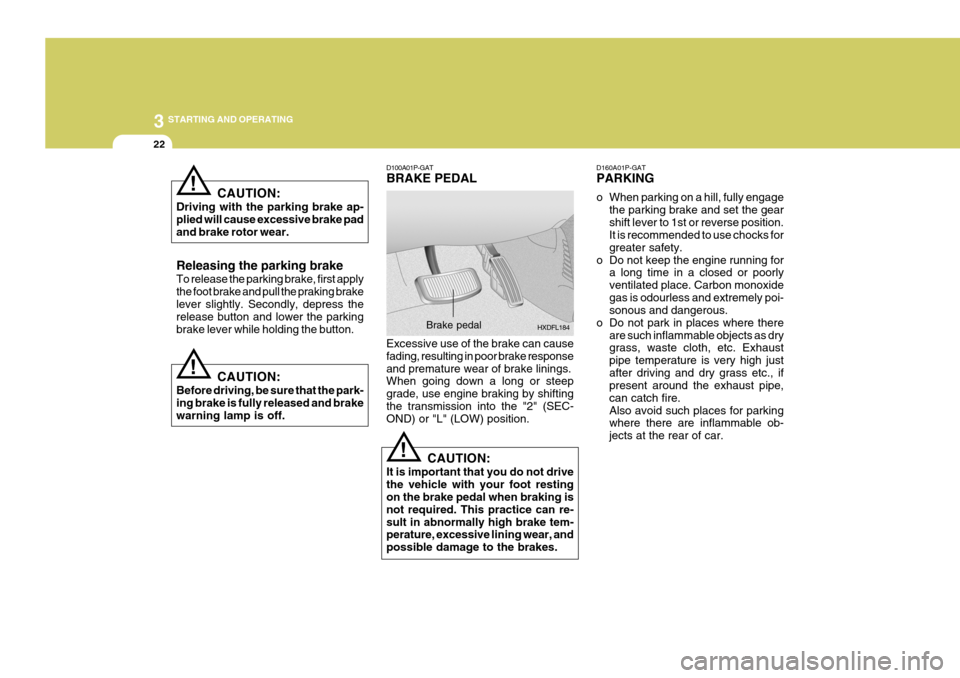
3 STARTING AND OPERATING
22
CAUTION:
Before driving, be sure that the park- ing brake is fully released and brakewarning lamp is off.! D160A01P-GAT PARKING
o When parking on a hill, fully engage
the parking brake and set the gear shift lever to 1st or reverse position. It is recommended to use chocks for greater safety.
o Do not keep the engine running for a long time in a closed or poorlyventilated place. Carbon monoxidegas is odourless and extremely poi- sonous and dangerous.
o Do not park in places where there are such inflammable objects as drygrass, waste cloth, etc. Exhaust pipe temperature is very high justafter driving and dry grass etc., if present around the exhaust pipe, can catch fire.Also avoid such places for parking where there are inflammable ob- jects at the rear of car.
D100A01P-GAT BRAKE PEDAL
CAUTION:
It is important that you do not drive the vehicle with your foot resting on the brake pedal when braking is not required. This practice can re-sult in abnormally high brake tem- perature, excessive lining wear, and possible damage to the brakes.
! HXDFL184
Brake pedal
Excessive use of the brake can cause fading, resulting in poor brake responseand premature wear of brake linings. When going down a long or steep grade, use engine braking by shiftingthe transmission into the "2" (SEC- OND) or "L" (LOW) position.
CAUTION:
Driving with the parking brake ap- plied will cause excessive brake pad and brake rotor wear. Releasing the parking brake To release the parking brake, first apply the foot brake and pull the praking brakelever slightly. Secondly, depress the release button and lower the parking brake lever while holding the button.
!
Page 165 of 284
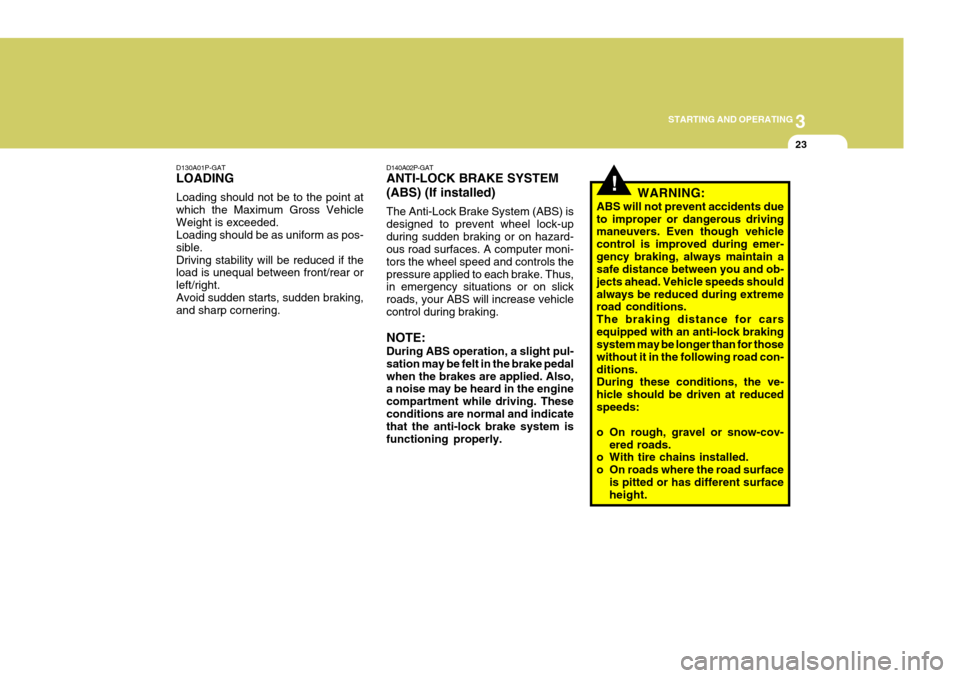
3
STARTING AND OPERATING
23
!
D140A02P-GAT ANTI-LOCK BRAKE SYSTEM (ABS) (If installed) The Anti-Lock Brake System (ABS) is designed to prevent wheel lock-upduring sudden braking or on hazard- ous road surfaces. A computer moni- tors the wheel speed and controls thepressure applied to each brake. Thus, in emergency situations or on slick roads, your ABS will increase vehiclecontrol during braking. NOTE: During ABS operation, a slight pul- sation may be felt in the brake pedalwhen the brakes are applied. Also, a noise may be heard in the engine compartment while driving. Theseconditions are normal and indicate that the anti-lock brake system is functioning properly. WARNING:
ABS will not prevent accidents dueto improper or dangerous driving maneuvers. Even though vehicle control is improved during emer-gency braking, always maintain a safe distance between you and ob- jects ahead. Vehicle speeds shouldalways be reduced during extreme road conditions. The braking distance for carsequipped with an anti-lock braking system may be longer than for those without it in the following road con-ditions. During these conditions, the ve- hicle should be driven at reducedspeeds:
o On rough, gravel or snow-cov- ered roads.
o With tire chains installed.
o On roads where the road surface
is pitted or has different surface height.
D130A01P-GAT LOADING Loading should not be to the point at which the Maximum Gross VehicleWeight is exceeded. Loading should be as uniform as pos- sible.Driving stability will be reduced if the load is unequal between front/rear or left/right.Avoid sudden starts, sudden braking, and sharp cornering.